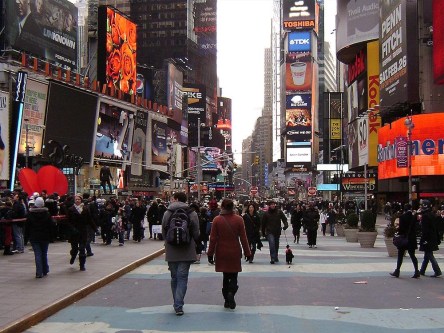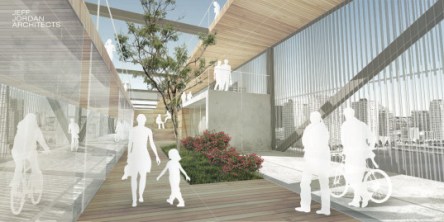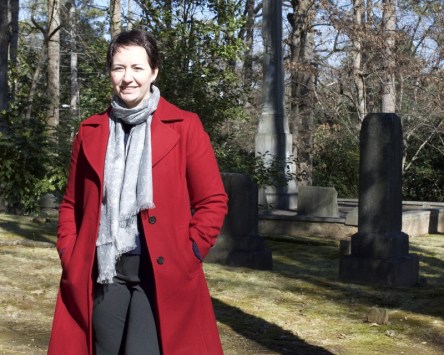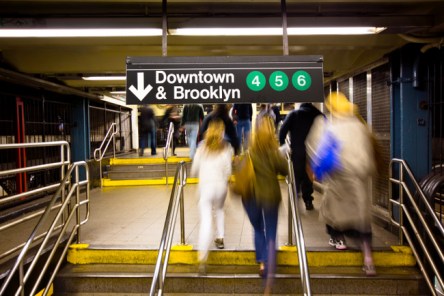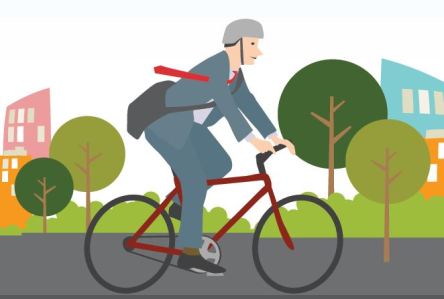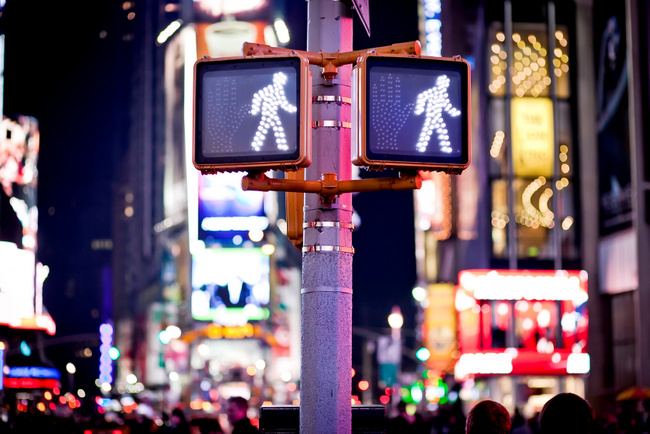“Big city” usually evokes buses, motorcycles, metro trains and cars. Beyond looking pretty and offering temporary respite from the bustle, does walkability—the ability to walk from home to shopping, dining, entertainment and employment spaces—add tangible value? Very much so, according to a new report that Yardi Matrix joined forces on with industry, academic and advocacy leaders. The Center for Real Estate & Urban Analysis (CREUA) at the George Washington University School of Business sponsored a study this year to rank the 30 largest metropolitan areas in the U.S. by how much office, retail and rental multifamily space lies in walkable urban areas. Multifamily rental asking rent data from Yardi Matrix went into the four-month effort, which also included contributions from real estate services firm Cushman & Wakefield, community quality-of-life advocate Smart Growth America, and real estate developer and investor coalition LOCUS. Yardi also contributed a $10,000 grant to support the research. The CREUA study identified 761 regionally significant walkable urban places, or “WalkUPs,” in those 30 metros. New York City has the most walkable urban real estate, followed by Denver, Boston, Washington, D.C., Chicago and San Francisco. The report documents that: Income-producing real estate (office, retail and rental housing) in walkable urban places has a 75% per square foot rent premium over other such real estate in the metro area. For-sale homes within WalkUPs have a 90% premium compared to the regional median for-sale home price in the metro area. The per-capita gross domestic product of the highest-ranked walkable urban metros is 52% higher than that of the seven lowest-ranked metros. “There is a ‘Doppler shift’ toward walkable urban development in the 30 largest U.S. metros,” Dr. Tracy Loh, senior data scientist at the George Washington School of Business and co-author of the report,...
Wonderful + Walkable
Embracing Active Cities
As the United States shifts from its 20th century car-centric automotive industry and further into the 21st century, cities around the country are beginning to step into the trend of walkability. Large, metropolitan cities are seeing a decrease in the number of cars, which makes room for bigger sidewalks and more pedestrians. Studies show that there are a multitude of benefits that come along with increasing a city’s walkability. From bettering your personal health, to contributing to bettering the city’s economy and infrastructure, to decreasing global warming, the wide range of positives is causing the popularity of this trend to take off. Increasing Physical and Mental Health Many people in metropolitan areas live very sedentary lives. They wake up, drive to work, and sit at their desks for hours before driving home for the day. Rinse and repeat. Physical inactivity can account for up to 10% of all deaths from noncommunicable diseases. With the implementation of compact and walkable distances, people can increase the amount of activity in their daily lives, leading to overall healthier lifestyles. Research shows that walking just 30 minutes a day is linked to an 18 percent decrease in heart disease. Sedentary lifestyles are often coupled with low levels of daily interaction. If you drive straight to work alone every day, social interactions would not be necessary. Walkable streets and areas can foster interactions that would not have taken place normally, such as striking up a conversation at a community park or meeting somebody at a coffee shop along a busy street. These small social interactions can contribute to a larger sense of community, which can in turn increase the overall positive mental health for citizens. Fostering a Vibrant and Active City A bustling city filled with pedestrians means a...
Safe Routes to Parks
Improve Health, Reduce Crime
Parks and Recreation Magazine recently published an article that offers insights into the benefits of green spaces. By promoting an active lifestyle and positively effecting human psychology, the Safe Routes to Parks program can transform the lives of the nation’s most vulnerable populations. Green spaces are a viable tool for improving public health and decreasing crime. Benefits of Green Spaces Research published in the Journal of Environmental Health Perspectives reveals that living in proximity to green space lowers the risk of all-cause, non-accidental mortality by 12 percent. Greenery reduces residents’ chances of dying from illnesses such as heart disease, diabetes, and cancer. Scott Brown at the University of Miami studied Medicare recipients in Miami-Dade County. Those who lived near green spaces experienced fewer chronic conditions: greenery reduced risk of diabetes by 14 percent, hypertension by 13 percent, and hyperlipidemia by 10 percent. The 2015 Urban Studies report finds that transforming vacant or gray spaces into green spaces reduces property crime and violent crime in the area. Marginalized neighborhoods—particularly urban, low-income communities—suffer in multiple ways from a shortage of green space. These communities are prone to crime, violence, poor air quality, and polluted waterways. Record-high obesity ratings, respiratory ailments, chronic disease and shorter life expectancy plague residents. Green spaces have the power to mitigate such ills in the communities that need them the most. Yet many high-risk neighborhoods lack green spaces. Those with parks face barriers to access. The National Recreation and Park Association’s Safe Routes to Parks Program aims to create parks and remove the barriers to attendance. Safe Routes to Parks Program The program first aims to create parks within a 10-minute walk of underserved communities. Studies reveal that residents within a 10-minute walk of a park have lower rates of obesity and...
NYC Liberty Bridge
Headed toward reality?
For many Jersey City is “the sixth borough,” even though at times it feels like it’s a world away from New York City. There are only a few miles from Manhattan to Jersey with the Hudson River crossing of about a mile. Yet, moving from one side of the Hudson to the other means taking a relatively circuitous route or using the busy PATH (Port Authority Trans-Hudson) system. The PATH system cannot keep up with the ever-higher number of commuters—240,000 people per work day—the ferry is expensive enough to make you want to call Uber, the train system is pretty unreliable, and tunnels need repairs. A new proposal might change all this. Kevin Shane, a 34-year-old Jersey City resident employed at the real estate crowdfunding company Sharestates, has invested much of his free time developing a plan that would enable commuters and tourists to bike or walk between downtown Jersey City apartments and Lower Manhattan. Yes, he envisioned a pedestrian bridge over Hudson—more than a mile long (1.5km) and more than 200 feet (60m) above the river. He envisioned another Liberty Bridge. Recently, Kevin met with Jersey City architect Jeff Jordan of Jeff Jordan Architects, who saw the greatness of Kevin’s daring idea and decided to join forces. Shortly after, Jordan jumped on board pro bono, releasing a series of appealing renderings that he designed with the assistance of his summer architecture interns and the Liberty Bridge turned from daydream to media darling. “It was provocative. I knew it would be a fun project to be involved in,” said Jordan, 38, who believes the bridge is buildable. “This isn’t a space station—it’s a bridge across a river. It comes down to money and will, but I think it’s feasible.” The Liberty Bridge idea is...
Bettering Buckhead
A community in transformation
It’s never too late to improve livability. Buckhead, an affluent and well-developed Atlanta submarket, demonstrates that notable change can be made even in established areas. Green space and cultural engagement are key to the transitioning community’s success. Markets experiencing the strongest, most sustainable growth these days are those where residents can work, live, and play in pedestrian-friendly communities. Ownership of a single-family home, an automobile, and long commutes from the suburbs don’t rank high on Millennials’ lists. Instead, they trend towards pedestrian neighborhoods with alternative transportation, active street scenes, and an emphasis on environmental stewardship. Buckhead fell woefully short in many of these areas. The submarket gained a reputation throughout metro Atlanta for its sprawling estates and commercial success but it was decidedly unapproachable and in many potential residents’ eyes, unlivable. Without major changes, Buckhead would sabotage its own growth and vitality. One spark initiated the necessary changes. In 2011, Denise Starling received a daunting task. The Executive Director at Livable Buckhead found herself facing a green space deficit and a demand for change. “Howard Shook is our councilman and he came to us and said ‘City of Atlanta just did this plan that identified my district as the lowest parked in the entire city of Atlanta. That can’t be. Go fix it!’ He literally said, ‘Go fix it!’” Starling laughs. “We’re like…alright. So that’s basically how we started a green space plan.” The councilman was right. At the time, the Community Improvement District, Buckhead’s commercial center, had only 2.14 acres of green space per thousand people. The standard is 15 acres. Establishing parks became the organization’s primary objective. Walkability was also a sought-after feature that Buckhead lacked. At the time, WalkScore dubbed the area as “car dependent,” entailing that most residents had to...
Top 20 Cities
For Walkable Urbanism
By now, you’ve probably heard that pedestrian-friendly access is all the buzz among Millennials and hip, active empty nesters. Mortgages and car notes are falling out of favor as these two large portions of the population steer towards rentals in walkable cities such as Seattle, Portland, and New York. A new study shines light on a few cities that are highly walkable and woefully overlooked. “Foot Traffic Ahead: Ranking Walkable Urbanism in America’s Largest Metros,” by Christopher B. Leinberger & Patrick Lynch of The George Washington University School of Business takes a quantitative approach to walkability in urban environments. Researchers evaluated the top 30 metros based upon the 2012 Brookings Institution methodology that pre-defined WalkUPs on geographical and economic terms. The selected cities were evaluated based upon economic performance and social equity performance. The findings were then used to rank the metros by current walkability and projections for walkability in the future. The 30 selected metropolitan areas are home to 46 percent of the population. Those metros also account for 58 percent of the national GDP. Interestingly, only one percent of all metropolitan land classifies as a WalkUP. If one percent seems unreasonably low to you, there is good reason for that. WalkUPs exclude owner-occupied spaces such as universities, medical centers, federal and state government buildings. There is not a consolidated database for such complexes from which researchers could pull information. This means that nearly 30-40 percent of employment spaces were excluded from the study. The current top six metros achieved Level 1 status, demonstrating the best distribution of walkable space in the urban core and surrounding suburbs. Level 1 listings represent 48 percent of all WalkUPs in the US. Within the rankings, cities such as Washington, D.C. outrank hipper destinations like...
Changing Lifestyles
More biking + walking
People have become increasingly preoccupied with well-being and seek healthier alternatives to everyday activities. Collaborative consumption, sustainable transportation choices, social connectivity and affordability have become guiding principles for a large part of the American population. The benefits of adopting such principles are indeed great and may include lowering carbon footprint by sharing transportation – whether bike or car sharing, or turning to mass transit for daily commutes, saving costs and resources by choosing collaborative workspaces, cutting down expenses by borrowing and recycling things, and increasing social gratification by engaging in such programs as crowdfunding and product service systems (PPS). This massive shift in consumer mindset has touched everything, from product preferences to lifestyle habits and housing choices. There is a growing demand for mixed-use communities and walkable environments in urban cores, particularly because working professionals and even empty nesters recognize de benefits of living more sustainably. Proximity to jobs, retail and entertainment options, access to public transportation and shared infrastructure systems, eco-friendly amenities and green spaces have become powerful incentives for attracting and retaining residents. As sustainability has become a word that sells and transportation is a major concern for most renters, multifamily operators are providing alternative options for getting around while allowing residents to be good stewards of the environment. Bike sharing has now evolved into a well-developed, high-tech amenity that provides real value to tenants engaged in daily commutes. Zagster, a company that provides turnkey bike sharing programs, is developing a national footprint of bike sharing programs in partnership with multi-family companies, businesses, hotel chains and universities, all of whom are looking to provide value added services and benefits to residents, guests or employees. More recently, the company teamed with Novare Group, a leading developer of cutting-edge, mixed-use high-rise communities in southeastern...
Walkability Rocks
Josh Herst to Speak at AIM
Prospects love apartments in walkable neighborhoods. And more likely than not, they are checking out what neighborhood attractions they could get to on foot before they even decide to come check out a potential new apartment community. Location-based technology has made assessing such neighborhood info as easy as can be. With a simple search on a service like Walk Score, potential residents know before they schedule a viewing appointment how far the community is from their favorite coffee shop, restaurant, or gym. And they are more likely to get excited about a new home that offers easy, convenient access to their favorite things. “One-third (of apartment renters) are willing to pay more to easily walk to their work, to entertainment and to restaurants,” said Josh Herst, CEO of Walk Score, at Inman Connects. Herst will be a featured speaker at the 2013 Apartment Internet Marketing conference, coming up from April 29 to May 1 in Huntington Beach. He’s slated to speak with 30Lines CEO Mike Whaling on “the uncharted digital marketing opportunity of maps, mapping, and location-based services.” Multifamily managers that want to harness the power of Walk Score can take advantage of the site’s walkable grading service with its built-in functionality on RentCafe marketing websites. See how it works in the image below. Clicking on the “Neighborhood” button brings up the Walk Score information for the community’s neighborhood, including what restaurants, grocery stores, parks, shopping and more can be found nearby. Prospects can drill down to get more detail on how the Walk Score is computed, search for other businesses they may be interested in having close by, and access easy lists in each location category that include distances, so they’ll know exactly how far the nearest bank, library or convenience store would be. “The score is primarily based on proximity to nearby amenities—grocery stores, restaurants, schools, parks, entertainment—the things that people want to be able to access regularly as part of their regular routine and errand running and such. As you may know, an increasing number of consumers are saying that access to these things is one of the most important criteria in deciding where to live, whether that’s buying a house or renting an apartment,” Herst told Multi-Housing News. “Location based technology like Walkscore also benefits communities that aren’t highly walkable,” says Esther Bonardi, Industry Principal of Yardi Marketing Solutions. “Apartment shoppers use these tools to understand how close goods and services are to the community, even if they don’t plan to walk there.” Indeed, incorporating neighborhood information in multifamily marketing strategy is a best practice for most communities, not just those in dense urban areas. RentCafe marketing websites also offer interactive Google maps that feature bird’s eye and street level views, providing consumers with a comprehensive overview of the neighborhood in a format they’re already accustomed to. Prospects will be impressed with the convenience and easy access to such vital neighborhood information – and they’ll be excited to rent an apartment near more than a few of their favorite...

